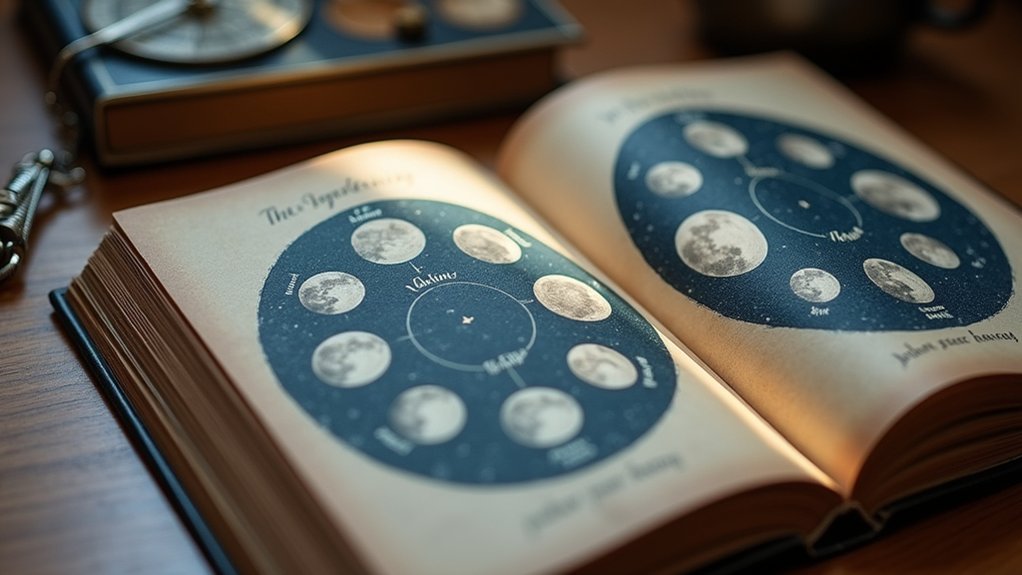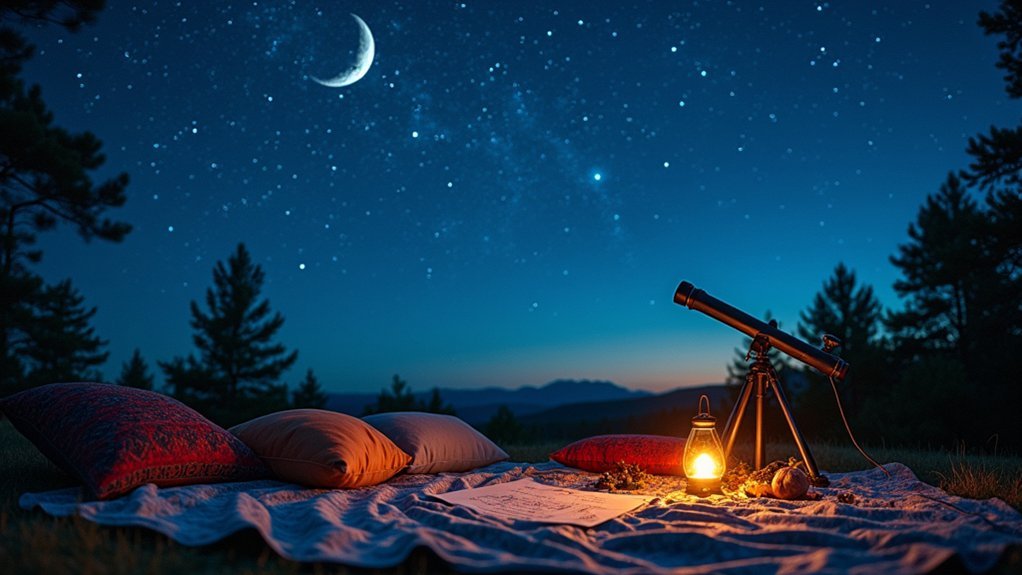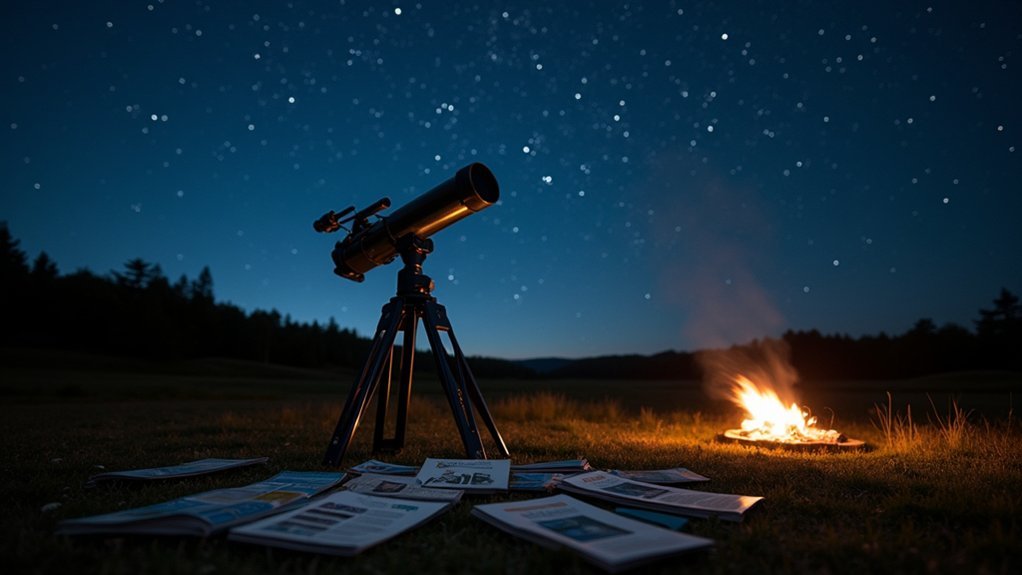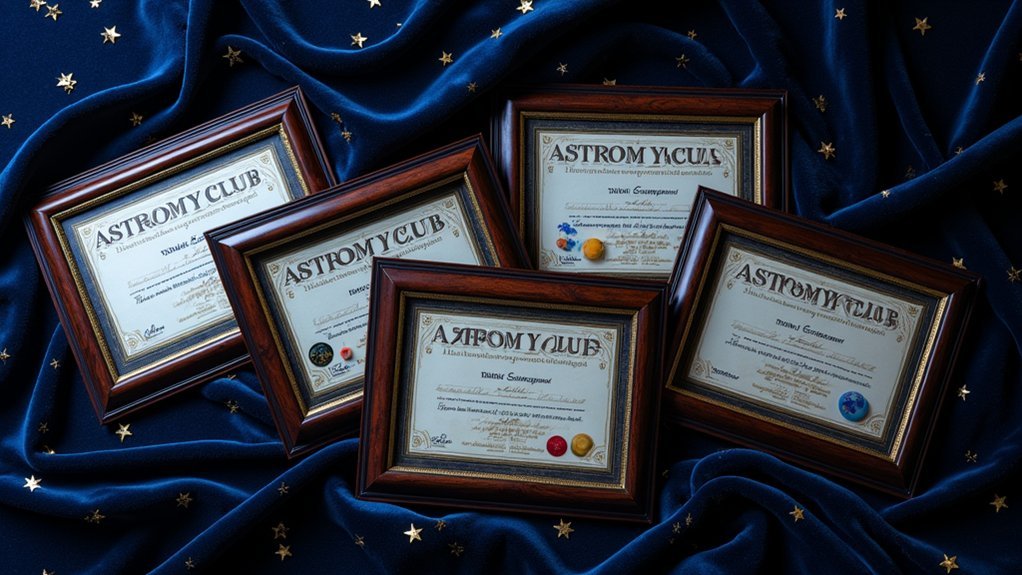Your first moon phase guide typically covers the eight primary phases from New Moon to Waning Crescent, explaining how the 29.5-day cycle works and what each phase signifies. You’ll find details about the science behind lunar illumination, cultural significance across history, and practical observation tips. Many guides include lunar gardening information and photography techniques for capturing different phases. The journey through lunar cycles connects ancient wisdom with your daily experience.
What’s Inside Your First Moon Phase Guide?

When you open your first moon phase guide, you’ll discover an extensive journey through the lunar cycle’s 12 distinct phases, from the New Moon to the Full Moon and back again.
You’ll learn how the moon’s orbit around Earth creates these phases as sunlight illuminates different portions of its surface throughout the month.
The guide will explain each phase’s unique characteristics and symbolic meanings—how the New Moon represents beginnings while the Full Moon signifies culmination.
You’ll find practical observation tips to track moon phases and understand their impact on tides and natural systems.
Expect helpful visual aids and diagrams illustrating the Earth-Moon-Sun positions during various Phases of the Moon, making complex astronomical concepts accessible as you begin your lunar observation journey.
Understanding the Eight Primary Moon Phases
The eight distinct moon phases—New Moon, Waxing Crescent, First Quarter, Waxing Gibbous, Full Moon, Waning Gibbous, Third Quarter, and Waning Crescent—create a predictable pattern throughout each 29.5-day lunar cycle.
You’ll notice each phase carries unique energetic qualities, from the invisible New Moon‘s invitation for intention-setting to the illuminated Full Moon’s peak of manifestation power.
As you track the moon’s journey through these phases, you’ll become attuned to how these energetic shifts influence your moods, creativity, and decision-making processes.
Naming Each Phase
Throughout the lunar cycle, eight distinct phases mark the Moon’s journey around Earth, each with its own name and unique appearance.
You’ll start with the New Moon, when the Moon sits between Earth and Sun, rendering it invisible from our perspective. As illumination increases, you’ll observe the Waxing Crescent, followed by the First Quarter when half the lunar face glows.
The Moon continues brightening into Waxing Gibbous before reaching its peak as the Full Moon, completely illuminated.
The cycle then reverses—Waning Gibbous appears as light decreases, followed by Third Quarter (another half-moon), and finally the Waning Crescent before returning to New Moon.
The entire lunar cycle takes approximately 29.5 days to complete, with each named phase representing a specific moment in this celestial dance.
Energetic Lunar Shifts
Beyond mere astronomical labels, these eight lunar phases carry distinct energetic signatures that influence our lives in subtle yet powerful ways.
Each phase offers a unique opportunity to align your activities with cosmic rhythms.
The New Moon invites you to set intentions and plant seeds for growth, while Waxing phases build momentum toward manifestation.
As you reach First Quarter, you’ll face decision points that strengthen your commitment to goals.
The Full Moon brings illumination and culmination—a perfect time to celebrate achievements or gain clarity on situations.
During Waning phases, energy shifts toward release and reflection.
The Third Quarter encourages you to let go of what no longer serves you.
The Science Behind the Lunar Cycle

The Moon’s 29.5-day journey around Earth creates the changing faces you’ll observe in our night sky.
As the Moon orbits, sunlight illuminates different portions of its surface, producing eight recognizable phases from the invisible New Moon to the fully bright Full Moon.
You’ll notice these phases follow a predictable pattern of waxing (increasing illumination) and waning (decreasing illumination) as the Moon completes its celestial dance.
Orbit And Illumination
While many simply enjoy the moon’s changing appearance, understanding its orbital mechanics reveals why these phases occur with such predictable regularity. The moon takes approximately 27 days to orbit around the Earth while simultaneously rotating on its axis at the same pace—a synchrony that keeps one side perpetually facing us.
What you observe as moon phases results from the relative positions of Earth, moon, and sun. During the New Moon phase, the moon positions itself between Earth and sun, with its illuminated portion facing away from you.
As it continues its lunar cycle, the visible illuminated portion gradually increases (waxes) until the Full Moon, then decreases (wanes) until returning to New Moon. This cyclical journey takes about 29.5 days, creating the predictable pattern you can track in your night sky observations.
Eight Distinct Phases
Throughout your lunar observation journey, you’ll encounter eight distinct phases that make up the complete 29.5-day cycle.
Starting with the New Moon (completely dark), you’ll observe the Moon’s gradual illumination during the Waxing Crescent phase, followed by the First Quarter, when half the lunar surface is visible as a semi-circle.
As illumination continues increasing, the Waxing Gibbous leads to the Full Moon, when the entire disk shines brightly.
Then begins the waning period – first as Waning Gibbous, then Third Quarter (another half-moon but opposite to First Quarter), and finally the Waning Crescent before returning to darkness.
These lunar phases result from changing positions between Moon, Earth, and Sun, revealing different portions of the illuminated lunar surface from your earthly perspective.
How to Track the 29.5-Day Lunar Month
Ever wondered how to follow the moon’s predictable dance across our night sky? Tracking the lunar month’s 29.5 days lets you connect with this ancient celestial rhythm and plan activities around specific moon phases.
The moon’s celestial waltz offers a 29.5-day window into nature’s oldest timekeeper, inviting us to sync with its rhythmic journey.
To effectively track the lunar cycle:
- Mark the new moon date on your calendar as your starting point.
- Note the primary phases occurring approximately every 7.4 days.
- Watch for the full moon, which signals the halfway point of your lunar journey.
- Use moon phase apps or calendars for visual guidance and exact timing.
Once you’ve completed a full cycle, you’ll develop an intuitive understanding of how the moon transforms.
This knowledge isn’t just fascinating—it’s practical for gardening, fishing, and connecting with natural rhythms that have guided humanity for millennia.
Distinguishing Between Waxing and Waning Phases

How do you tell if the moon is growing or shrinking in the night sky? It’s all about which side is illuminated.
During waxing phases, which occur after the new moon, the right side brightens in the Northern Hemisphere. You’ll notice the Waxing Crescent phase first, appearing as a slim, right-lit curve symbolizing growth.
As the illuminated portion increases, you’ll see the First Quarter phase, showing exactly half the moon lit up—perfect for setting intentions.
When the moon’s waning, the left side remains bright while darkness grows from the right. The Waning Gibbous follows the full moon, with more than half still illuminated but gradually decreasing.
This phase encourages reflection and release as the moon returns to darkness.
New Moon to Full Moon: The Growth Cycle
When the moon aligns between Earth and the sun, the New Moon marks the beginning of its growth cycle, appearing completely dark from our perspective.
As you track the lunar cycle, you’ll notice a pattern of increasing illumination that represents expansion and manifestation.
The growth phases include:
The moon’s growth phases guide us through intention setting, momentum building, decision points, and the final push toward completion.
- New Moon – The perfect time to set intentions and plant seeds for what you want to develop
- Waxing Crescent – Watch for the first sliver of light appearing, signaling a time of growth and building momentum
- First Quarter – Half the moon is now visible, presenting a time for decision-making and overcoming obstacles
- Waxing Gibbous – Nearly full illumination prepares you for completion before reaching the full moon’s powerful culmination
Tools and Apps for Moon Phase Observation
Tracking lunar phases has never been easier thanks to the abundance of digital and physical tools available today. Mobile apps like Moon Phase Calendar and Phases of the Moon offer real-time updates on lunar events with customizable notifications for specific phases you don’t want to miss.
For detailed planning, websites like timeanddate.com provide extensive moon phase calendars with rise and set times. If you’re more visually oriented, astronomy software such as Stellarium lets you simulate the night sky for any location and date, enhancing your observation strategy.
Coastal enthusiasts will appreciate tidal prediction apps that use moon phase data to forecast water levels.
And for those who prefer traditional methods, physical moon phase tracking calendars and charts offer quick reference points throughout the month.
Cultural Significance of Moon Phases Across History
You’ll find that ancient civilizations from the Maya to Babylonians structured their entire way of life around lunar calendars, using moon phases to determine planting times, religious festivals, and seasonal changes.
The Harvest Moon—the full moon nearest the autumn equinox—held particular significance for agricultural societies across Europe and Asia, providing essential extended evening light for farmers completing their harvests.
These lunar traditions continue today in celebrations like China’s Mid-Autumn Festival and various indigenous ceremonies, revealing how the moon’s rhythms have shaped human culture for millennia.
Ancient Lunar Calendars
Throughout history, civilizations across the globe have turned to the night sky for guidance, developing sophisticated lunar calendars that shaped their understanding of time.
These ancient systems tracked the moon’s predictable 29.5-day cycle, connecting cosmic patterns to earthly activities.
You’ll discover that lunar calendars served multiple purposes across cultures:
- Agricultural planning – Babylonians and Egyptians timed planting and harvesting with lunar phases
- Religious observances – The Islamic calendar determines Ramadan through new moon sightings
- Seasonal celebrations – Chinese lunar calendar still guides festivals like Mid-Autumn Festival
- Spiritual connection – Indigenous and Maya peoples incorporated moon phases into their rituals and ceremonies
These calendars weren’t merely timekeeping tools—they represented sophisticated understanding of astronomy, spirituality, and humanity’s place within natural cycles.
Harvest Moon Traditions
As twilight fades and autumn approaches, the Harvest Moon emerges as perhaps the most celebrated lunar event across diverse cultures worldwide. This Full Moon closest to the autumnal equinox once extended precious working hours for farmers gathering their crops.
You’ll find that Native American tribes named this moon specifically to mark the harvest season, while ancient Celts used it as a time for thanksgiving feasts.
| Culture | Celebration | Agricultural Significance |
|---|---|---|
| Chinese | Mid-Autumn Festival | Family reunions with mooncakes |
| Native American | Naming ceremonies | Extended harvesting time |
| Celtic | Thanksgiving feasts | Honoring earth’s bounty |
Today, you can connect with these traditions by observing the Harvest Moon yourself. Its bright illumination reminds us of our ancestral ties to seasonal rhythms and the critical relationship between celestial bodies and agricultural cycles throughout human history.
Photographing Different Lunar Appearances
Photography enthusiasts can capture the moon’s ever-changing face throughout its monthly cycle, with each phase offering distinct visual opportunities.
The moon presents photographers with an ever-shifting celestial canvas, offering unique visual rewards through each lunar phase.
When photographing these celestial events, you’ll need proper equipment and timing to showcase the moon’s beauty.
- New Moon – Plan your shoot during a solar eclipse when the moon positions between Earth and sun, otherwise it remains invisible.
- Waxing Crescent – Look to the western sky after sunset to catch this slender illuminated curve.
- Full Moon – Use a telephoto lens to capture surface details while the moon is fully illuminated from sunset to sunrise.
- Waning Gibbous – Photograph in early morning hours with the left side illuminated (Northern Hemisphere).
Always use a tripod to eliminate camera shake and guarantee sharp images regardless of lighting conditions.
The Moon’s Influence on Earth’s Tides
While the moon enchants photographers with its changing faces, its gravitational pull orchestrates a much more powerful phenomenon on our planet. You’ll notice Earth’s tides rise and fall as the moon orbits us, creating predictable patterns sailors and fishermen have relied on for centuries.
During full moon and new moon phases, you’ll experience spring tides—the highest tidal ranges when the sun, moon, and Earth align perfectly. These dramatic tides create diverse ecosystems like tidal pools that teem with marine life.
| Moon Phase | Tidal Effect | Best Viewing Locations |
|---|---|---|
| Full Moon | Highest spring tides | Bay of Fundy, Canada |
| New Moon | Highest spring tides | Mont Saint-Michel, France |
| Quarter Moon | Moderate neap tides | Sydney Harbour, Australia |
| Waxing/Waning | Gradually changing | Great Barrier Reef, Australia |
| All Phases | Creates tidal pools | Olympic National Park, USA |
Gardening by the Lunar Calendar
For thousands of years, keen gardeners have aligned their planting schedules with the moon’s rhythmic journey across our night sky.
You’ll find your harvests improve when you work with these natural cycles instead of against them.
Follow these lunar gardening principles to maximize your success:
- New Moon to Waxing Crescent Moon – Plant seeds for above-ground crops as increasing light stimulates leafy growth.
- First Quarter Moon – Focus on root crops, which thrive with the balanced moisture this phase provides.
- Full Moon – Harvest your bounty when energy and moisture levels peak.
- Waning Crescent Phase – Time for maintenance—prune, remove weeds, and prepare for the next planting cycle.
Celestial Events Related to Moon Phases
As our lunar companion circles Earth, it creates spectacular astronomical displays that have captivated humanity since ancient times.
During the new moon phase, you might witness a solar eclipse when the moon perfectly aligns between Earth and sun, temporarily darkening the daytime sky.
The full moon offers its own celestial drama when lunar eclipses occur as Earth casts its shadow across the lunar surface.
Keep watch for supermoons, when a full moon coincides with the moon’s closest approach to Earth, appearing remarkably larger and brighter in the night sky.
Moon phases also influence our oceans, with spring tides bringing the highest water levels during new and full moons.
These predictable cosmic rhythms continue to shape agricultural practices and cultural celebrations around the world.
Northern vs. Southern Hemisphere Moon Viewing Differences
The moon’s appearance changes dramatically depending on your location in the world. When you observe moon phases from different hemispheres, you’ll notice significant variations in how the celestial body presents itself:
- During the waxing crescent phase, the illuminated portion appears on the right side in the Northern Hemisphere but on the left side in the Southern Hemisphere.
- A full moon rises in the east and sets in the west for Northern Hemisphere viewers, while Southern Hemisphere observers see it travel across the northern sky.
- The waxing gibbous moon bulges toward the top when viewed from the Northern Hemisphere, but toward the bottom from the Southern Hemisphere.
- Both hemispheres experience moonrise around sunset during a full moon, though the angle of its path varies considerably between north and south.
Frequently Asked Questions
What Comes First in the Moon Phase?
The New Moon comes first in the moon phase cycle. You won’t see it because it’s hidden between Earth and the Sun, rising and setting with the Sun, before shifting to the Waxing Crescent phase.
How Do We Know What’s Inside the Moon?
You’ve learned about the Moon’s interior through Apollo mission seismic studies, lunar sample analysis, and modern spacecraft imaging. These scientific methods reveal its crust, mantle, and partially molten core structure without direct exploration.
How Does the First Quarter Moon Affect Your Mood?
During the First Quarter Moon, you’ll likely feel increased energy and motivation. Your mood may shift toward optimism and assertiveness, pushing you to make decisions and take action on goals you’ve been contemplating.
What Are the 12 Phases of the Moon in Order?
The 12 moon phases in order are: New Moon, Waxing Crescent, First Quarter, Waxing Gibbous, Full Moon, Waning Gibbous, Third Quarter, Waning Crescent, Balsamic Crescent, Dark Moon, Disseminating Balsamic Crescent, and Growing Crescent.
In Summary
You’re now equipped to track and interpret the moon’s journey across our night sky. Whether you’re planning a garden, watching tides, or simply appreciating lunar beauty, your guide helps you connect with this celestial companion. Remember that the moon’s phases look different depending on your hemisphere. You’ll find that following the lunar cycle adds a meaningful rhythm to your daily life.





Leave a Reply